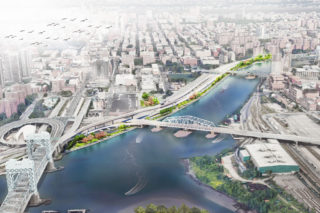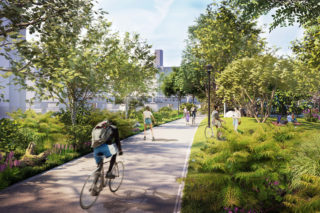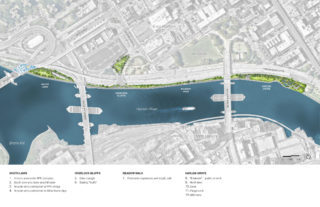Manhattan Greenway Harlem River will make waterfront recreation accessible to the East Harlem community in Upper Manhattan, and connect cyclists from Randall’s Island, the South Bronx, and Upper Manhattan to the entirety of the Manhattan Waterfront Greenway. This project extends the Greenway along a 4,000 linear foot stretch of the Harlem River shoreline. The site has been used for construction staging for decades and has long been a "missing link" in the city’s shoreline. Located between 125th and 132nd streets in East Harlem, this project will create 7 acres of parkland with passive lawns, fitness areas, a playground, public art, and community gathering spaces for fishing, grilling, and performance. East Harlem is a vibrant and diverse neighborhood that is physically and socially vulnerable to climate risks such as coastal flooding. Historically, the neighborhood’s residents have not enjoyed ease of access to waterfront recreation. Up to the 1950s, East Harlem was connected directly to the river by several public spaces, but the construction of Harlem River Drive severed all at-grade pedestrian access to the waterfront. The entrance to the new park at 127th Street will create the only at-grade access to the Manhattan Waterfront Greenway along a 7-mile stretch from 96th Street to Dyckman Street. In addition to reestablishing pedestrian connections to the neighborhood, the new park will create access to regional cycling networks for residents. The park features a bicycle path and waterfront esplanade that connect the open space at its northern and southern extents to existing segments of the Greenway. Two new ramps from the RFK Bridge and Willis Avenue Bridge will allow cyclists coming from the South Bronx and Randall’s Island to seamlessly access the waterfront, open space amenities, and commuter routes throughout Manhattan. The client team, comprised of New York City Economic Development Corporation and NYC Parks, asked the design team to address four related issues: connectivity, waterfront activation, cost-effective design, and resilience. Creating pedestrian and bicycle connectivity required coordination with several ongoing infrastructure projects, each overseen by a different city agency. The program for waterfront activation was directly shaped by feedback from community engagement beginning in 2017. To be cost effective, the design primarily uses NYC Parks and NYC Department of Transportation standard details, which are creatively deployed to make welcoming spaces. Lastly, to address climate resilience, the bulkhead platform upon which much of the park will be built is designed to to elevate the park and reduce risk of flooding from sea level rise and 10-year storms. The platform is engineered with additional structural adaptive capacity, which will allow the platform to be further elevated and integrated with flood protection in anticipation of future coastal storms. Designing this project – which will begin construction in early 2023 – has been all about creating connections: restoring the physical connection between the Harlem River and East Harlem, linking up cyclists and pedestrians with New York City’s greenway network, making nature accessible to people of all ages and abilities, and imagining new relationships between health, culture, and community.
Project facts
Location New York, NY
Project Lead Langan Engineering
Landscape Architect Starr Whitehouse Landscape Architects and Planners
Year 2017
Project Team Goldstick Lighting; Indigo River; One Architecture and Urbanism; Suzanne Randolph Fine Arts
Category Transportation & Infrastructure
AIANY Recognition
2022 AIANY + ASLANY Transportation + Infrastructure Design Excellence Awards










